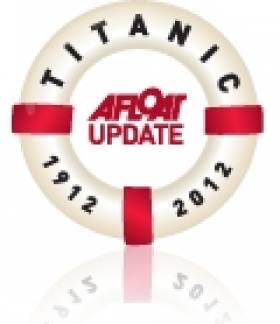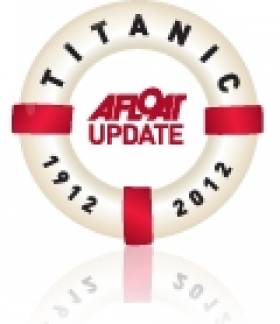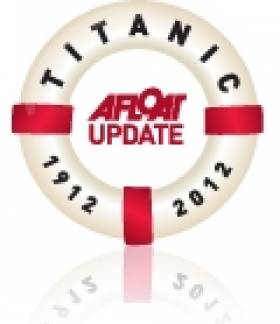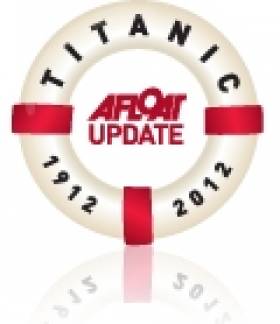Displaying items by tag: Titanic
Titanic Auction Takes The Biscuit As Cracker Fetches €21,000
#Titanic - A Greek collector has paid £15,000 (€21,000) for a pilot cracker found in a lifeboat kit from the Titanic, as BBC News reports.
Aptly described as "the world's most valuable biscuit" by auctioneer Andrew Aldridge, the Spillers and Bakers cracker was one of a number of items relating to the Titanic tragedy that sold at auction in October.
Among them was a photo showing what's believed to be the iceberg that the liner struck on that fateful night on 14 April 1912, and a 'loving cup' presented to the captain of the Carpathia, which responded to the Titanic's distress calls, that went to a British-based collector for a whopping £129,000 (€181,000).
BBC News has more on the story HERE.
Titanic Drawing Offices To Be Restored As Luxury Hotel
#Titanic - The drawing offices where the Titanic was designed could soon become a four-star hotel for Belfast's historic quarter.
According to The Irish Times, the British Heritage Lottery Fund has provided a grant of almost £5 million (€6.6m) to convert the former Harland and Wolff headquarters into 84 rooms of boutique accommodation.
And while no hotel group has as yet confirmed plans to take over the historic site at the Titanic Quarter, it's believed that the restoration funding will make the investment "much more commercially attractive".
The Titanic was not the only famous vessel to get its start at the H&W drawing offices – her sister ships the Olympic and Brittanic were also designed there, as was the warship HMS Belfast, now docked as a floating museum in London, and more than 1,000 other vessels.
The Irish Times has more on the story HERE.
A New Tall Ship For Ireland? It's Back to The Future
#tallship – The Tall Ships return to Ireland in spectacular style this summer with a major fleet assembly in Belfast from Thursday 2nd to Sunday 5th July for the beginning of the season's Tall Ships Races, organised by Sail Training International. The seagoing programme will have a strong Scandinavian emphasis in 2015, with the route - some of which is racing, other sections at your own speed – starting from Belfast to go on Aalesund in western Norway for 16th to 18th July, thence to Kristiansand (25th to 28th July), which is immediately east of Norway's south point, and then on to conclude at Aalborg in northern Denmark from 1st to 4th August.
But before leaving Northern Ireland with the potentially very spectacular Parade of Sail down Belfast Lough on Sunday July 5th, the celebrations will be mighty. The fleet's visit will be the central part of the Lidl Belfast Titanic Maritime Festival, which will include everything from popular family fun happenings with concerts and fireworks displays – the full works, in other words – right up to high–powered corporate entertainment attractions.
As for the ships, there will be more than enough for any traditional rig and tall ship enthusiast to spend a week drooling over. In all, as many as eighty vessels of all sizes are expected. But more importantly, at least twenty of them will be serious Tall Ships, proper Class A square riggers of at least 40 metres in length, which is double the number which took part in their last visit to Belfast, back in 2009.
That smaller fleet of six years ago seemed decidedly spectacular to most of us at the time. So the vision of a doubling of proper Tall Ship numbers in Belfast Harbour is something we can only begin to imagine. But when you've a fleet which will include Class A ships of the calibre of the new Alexander von Humboldt from Germany, Norway's two beauties Christian Radich and Sorlandet, the much-loved Europa from the Netherlands, George Stage from Denmark, and the extraordinary Shtandart from Russia which is a re-creation of an 18th Century vessel built for Emperor Peter the Great, you're only starting, as that's to name only six vessels – what we'll be seeing will be a truly rare gathering of the crème de la creme.
So although it would be stretching it to think that a small country like Ireland should aspire to having a major full-rigged vessel, we mustn't forget that for 27 glorious years we did have our own much-admired miniature Tall Ship, the gallant 84–ft brigantine Asgard II. Six-and-a-half years years after her loss, it's time and more for her to be replaced. W M Nixon takes a look at what's been going on behind the scenes in the world of sail training in Ireland and finds that, in the end, we may find ourselves with a ship which will look very like a concept first aired for Irish sail training way back in 1954.
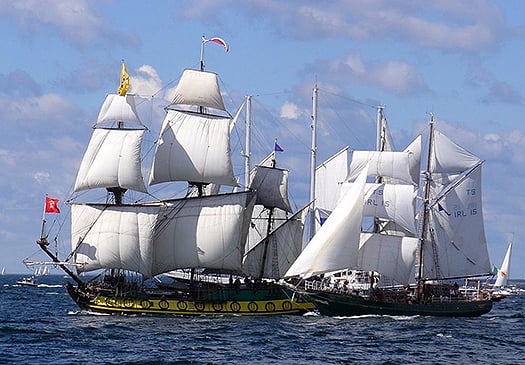
The pain of it. You search out a photo of Shtandart, the remarkable Russian re-creation of an 18th century ship, and you find that Asgard II is sailing beside her
It was while sourcing a photo of Russia's unusual sail training ship Shtandart that the pain of the loss of Asgard II emerged again. It's always there, just below the surface. But it's usually kept in place by the thought that we have to move on, that worse things happened during the grim years of Ireland plunging ever deeper into recession, and that while our beloved ship did indeed sink, no lives were loss and her abandonment was carried out in an exercise of exemplary seamanship.
Yet up came the photo of the Shtandard, and there right beside her was Asgard II, sailing merrily along on what's probably the Baltic, and flying the flag for Ireland with her usual grace and charm. The pain of seeing her doing what she did best really was intense. She is much mourned by everyone who knew her, and particularly those who crewed aboard her. All three of my sons sailed on her as trainees, they all had themselves a great time, and two of them enjoyed it so much they repeated the experience and both became Watch Leaders. It was very gratifying to find afterwards, when you went out into the big wide world and put "Watch Leader Asgard II" on your CV, that it counted for something significant in international seafaring terms.
But as a sailing family with other boat options to fall back on, we didn't feel Asgard II's loss nearly as acutely as those country folk for whom the ship provided the only access to the exciting new world of life on the high seas.

Elaine Byrne vividly recalls how much she appreciated sailing on Asgard II, and how she and her siblings, growing up in the depths of rural Ireland, came to regard the experience of sailing as a trainee on the ship as a "Rite of Passage" through young adulthood
The noted international investigative researcher, academic and journalist Dr Elaine Byrne is from the Carlow/Wicklow border, the oldest of seven children in a farming family where the household income is augmented with a funeral undertaking business attached to a pub in which she still occasionally works. Thus her background is just about as far as it's possible to be from Ireland's limited maritime community. Yet thanks to Asgard II, she was able to take a step into the unknown world of the high seas as a trainee on board, and liked it so much that over the years she spent two months in all aboard Asgard II, graduating through the Watch Leader scheme and sailing in the Tall Ships programmes of races and cruises-in-company
Down in the depths of the country, her new experiences changed the Byrne family's perceptions of seafaring. Elaine Byrne writes:
"Four of my siblings (then) had the opportunity to sail on Asgard II. If it were not for Asgard II, my family would never have had the chance to sail, as we did not live near the sea, nor had the financial resources to do so. The Asgard II played a large role in our family life as it became a Rite of Passage to sail on board her. My two youngest siblings did not sail on the Asgard II because she sank, which they much regret".
She continues: "Apart from the discipline of sailing and the adventure of new experiences and countries, the Asgard brought people of different social class and background together. There are few experiences which can achieve so much during the formative years of young adulthood"
That's it from the heart – and from the heart of the country too, from l'Irlande profonde. So, as the economy starts to pick up again, when you've heard the real meaning of Asgard II expressed so directly then it's time to expect some proper tall ship action for Ireland in the near future. But it's not going to be a simple business. So maybe we should take quick canter through the convoluted story of how Asgard II came into being, in the realization that in its way, creating her successor is proving to be every bit as complex.
As we shall see, the story actually goes back earlier, but we'll begin in 1961 when Erskine Childers's historic 1905-built 51ft ketch Asgard was bought and brought back by the Irish government under some effective public pressure. It was assumed that a vessel of this size – quite a large yacht by the Irish standards of the time – would make an ideal sail training vessel and floating ambassador. It was equally assumed that the Naval Service would be happy to run her. But apart from keen sailing enthusiasts in the Naval Reserve - people like Lt Buddy Thompson and Lt Sean Flood – the Naval Service had enough on its plate with restricted budgets and ageing ships for their primary purpose of fishery patrol.
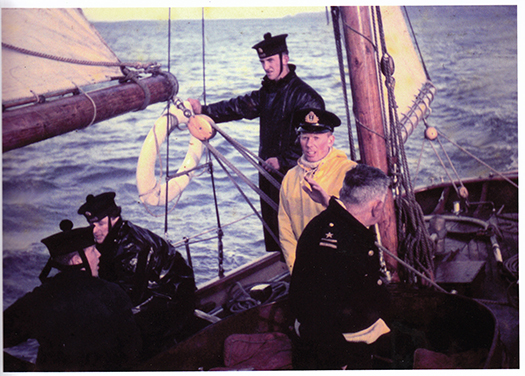
Aboard the first Asgard in 1961 during her brief period in the 1960s as a sail training vessel with the Naval Service – Lt Sean Flood is at the helm
So Asgard was increasingly neglected throughout the 1960s until Charlie Haughey, the new Minister for Finance and the only member of Government with the slightest interest in the sea, was persuaded by the sailing community that Asgard could become a viable sail training ship. In 1968 she was removed from the remit of the Department for Defence into the hands of some rather bewildered officials in the Department for Finance, and a voluntary committee of five experienced sailing people - Coiste an Asgard - was set up to oversee her conversion for sail training use in the boatyard at Malahide, which just happened to be rather less than a million miles from the Minister's constituency.
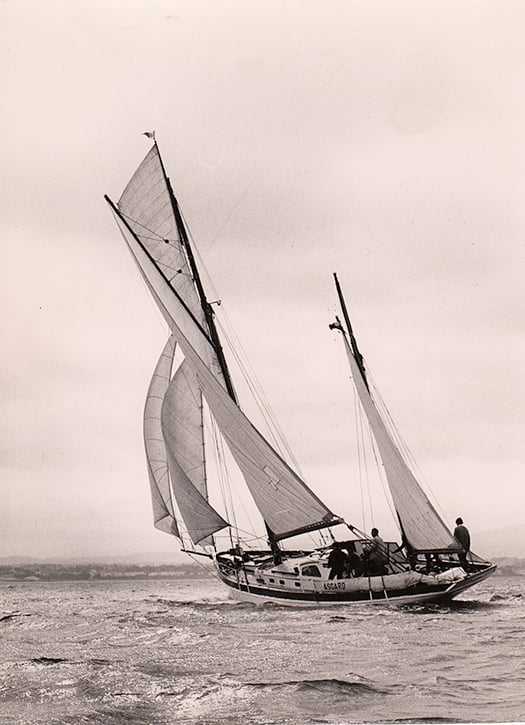
Asgard in her full sail training role in 1970 in Dublin Bay
Asgard was commissioned in her new role in Howth, the scene of her historic gun running in 1914, in the spring of 1969. Under the dedicated command of Captain Eric Healy, the little ship did her very best, but it soon became obvious that her days of active use would be limited by reasons of age, and anyway she was too small to be used for the important sail training vessel roles of providing space to entertain local bigwigs and decision-makers in blazers.
By 1972, the need for a replacement vessel was a matter of growing debate in the sailing community, and during a cruise in West Cork in the summer of 1972, I got talking to Dermot Kennedy of Baltimore out on Cape Clear. Dermot was the man who introduced Glenans to Ireland in 1969, and then he branched out on his own in sail training schools. A man of firm opinions, he reacted with derision to my suggestion that Asgard's replacement should be a modern glassfibre Bermudan ketch, but with enough sails to keep half a dozen trainees busy.
"Nonsense" snorted Dermot. "Ireland needs a real sailing ship, a miniature tall ship maybe, but still a real ship, big enough to carry square rig and have a proper clipper bow and capture the imagination and pride of every Irish person who sets eyes on her. And she should be painted dark green just to show she's the Irish sail training ship, and no doubt about it".
Some time that winter I simply mentioned his suggestions in Afloat magazine, and during the Christmas holidays they were read by Jack Tyrrell at his home in Arklow. During his boyhood, in the school holidays he had sailed with his uncle on the Arklow schooner Lady of Avenel, and it had so shaped his development into the man who was capable of running Ireland's most successful boatyard that he had long dreamed of a modern version of the Lady of Avenel to be Ireland's sail training ship.
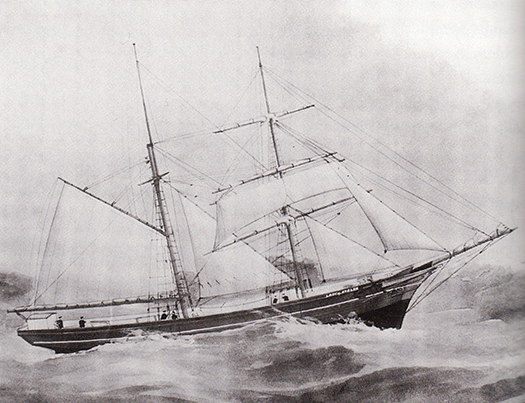
The inspiration – Jack Tyrrell's boyhood experiences aboard Lady of Avenel inspired him to create Ireland's first proper sail training ship
In fact, in 1954 he had sketched out the plans for a 110ft three masted training ship, but Ireland in the 1950s was in the doldrums and the idea got nowhere. Yet the spark was always there, and it was mightily re-kindled by what Dermot Kennedy had said. So at that precise moment, the normal Christmas festivities in the Tyrrell household were over. They'd to continue the celebrations without the head of the family. The great man took himself off down to the little design office in his riverside boatyard, and in clouds of pipe tobacco smoke, he re-drew the lines of the 110ft three master to become an 83ft brigantine, the size reduction meaning that the shop would only need a fulltime crew of five.
Working all hours, he had the proposal drawings finished in time to rejoin his family to see in the New Year. And in the first post after the holiday, we got the drawings at Afloat, and ran them in the February 1973 issue.
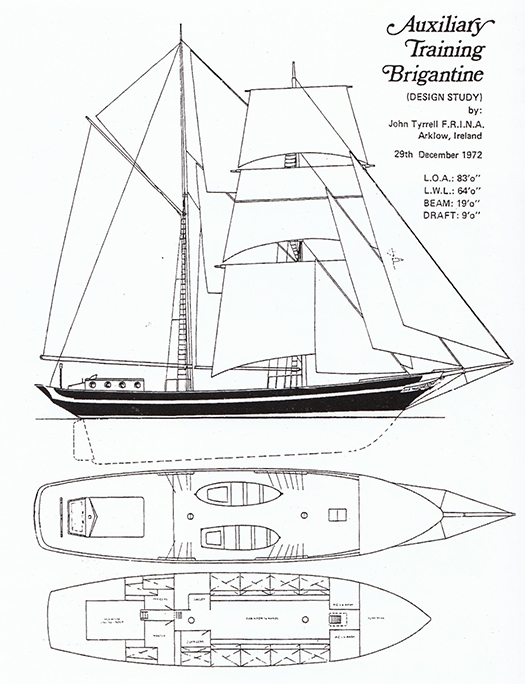
Jack Tyrrell's proposal drawings for the new brigantine, as published in the February 1973 Afloat
In Ireland then as now, most politicians had inscribed in their heads the motto: "There's No Votes In Boats". So after Charlie Haughey had fallen from favour with the Arms Trial of 1970, Coiste an Asgard became an orphan. But 1973 brought a new government, and there was one cabinet minister in it who was proud to proclaim his allegiance to the sea.
Unfortunately for the respectability of the maritime movement in Ireland, our supporters in the higher echelons of politics have often tended to be from the colourful end of the political spectrum, whatever about their placing in the left-right continuum. Thus it was that, at mid-morning on St Patrick's Day 1973, I got an ebullient phone call and an immediate announcement, without the caller saying who he was. "Winkie" he bellowed, "That ship is going to be built. I'll make sure of it. I've just made a ministerial decision".
It emerged that it was our very own new Minister for Defence, Patrick Sarsfield Donegan TD. The enthusiasm for the new ship, engendered by studying Jack Tyrrell's drawings, led to a snap decision which stayed decided, and it all happened in the Department for Defence.
However, it was 1981 by the time the ship was launched, and she looked rather different from Jack Tyrrell's preliminary drawings, though the basic hull shape built in timber was the same sweet lines as originally envisaged, so she was able to sail like a witch. But as for her supporters at Government level, the non-stop cabaret continued. Charlie Haughey had regained power, and by 1981 he was Taoiseach. It was he who had seen to it that the Department of Defence continued to look after the Asgard II project with support from another sailing TD who might not have seen eye–to-eye with him on other matters, Bobby Molloy of Galway.
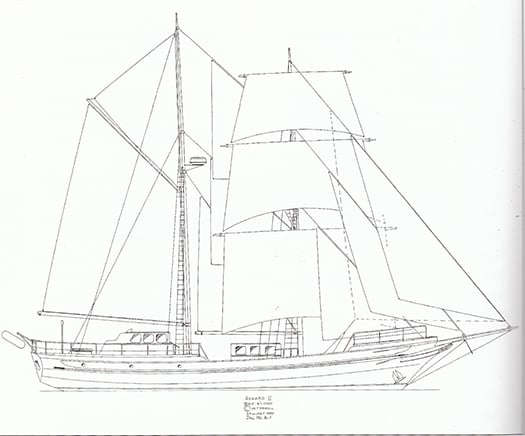
Asgard II in her finished form
So on a March day in 1981, almost exactly twelve years after he'd commissioned the original Asgard in her new role as a sail training vessel, Charlie Haughey took it upon himself to christen the new Asgard II in Arklow basin. And the champagne bottle refused to break. Five or six time he tried, but with no success.
Showing considerable grace under pressure and observed by a large crowd, he quietly took his time undoing all the ribbons and paraphernalia on the big bottle. Then he marched with it up to the new flagship's stem, and hit it a mighty double-handed wallop. The bottle exploded that time, with no mistake. And apart from the usual Haughey growl to those nearby about the idiocy of whoever forgot to score the champagne bottle beforehand, it was all done with the best of humour.
For most of her subsequent career, there's no doubt Asgard was a lucky and very successful vessel. Yet when her demise came, you couldn't help but think of the old notion that if the champagne bottle doesn't break first time, then she'll ultimately be an unlucky ship.
But there are more prosaic explanations. With a limited budget and every penny being scrutinized, Jack Tyrrell and his men had to build Asgard II in fishing boat style, which is fine within its proper time span, but that time span is really only twenty years, maybe thirty if the ship gets extra care. But with her fishing boat hull carrying a demanding brigantine rig, although she always looked immaculate, Asgard II was starting to show her age in the stress areas.
By 2005 there was serious talk about the need to plan for a replacement. When her skipper Colm Newport was told to renew her rig as the original spars were clearly well past it, he meticulously searched the best timber yards at home and abroad and when she got her new rig – it was 2006 or thereabouts – I wrote an only slightly tongue-in-cheek article suggesting that now was the time to replace her old tired wooden hull with a new steel one to the same Jack Tyrrell lines, but utilising the excellent new rig and as many of the fixtures and fittings as were still in good order from the original ship.
To say the response was negative is understating the case. People's attachment to Asgard could only imagine a wooden ship. It was the end of any meaningful debate. So things drifted on, with each new government seemingly even less interested in maritime matters generally, and sail training in particular, than the one before.
In September 2008, Asgard started taking in water while on passage with a crew of trainees towards La Rochelle for a maritime festival following which - while still in La Rochelle – it was planned that she would be lifted out for a thorough three week survey and maintenance programme.

Asgard's accommodation worked superbly whether at sea or in port. But the fact that so much was packed into a relatively small hull meant that some areas were almost inaccessible for proper inspection
It might have been the saving of her. But it was not to be. It's said that it was a failed seacock which caused the catastrophic ingress of water. She was a very crowded little ship, she packed a lot into her 84ft, so some hull fittings were less accessible internally than they would be in a more modern vessel, and may have deteriorated to a dangerous level. But if, as some would propose, she hit something in the water which caused a plank to start, then the fact that nobody aboard was aware of any impact suggests that the time for a major overhaul, and preferably a hull replacement, was long overdue.
The moment Asgard II sank, she ceased to have any future as a sail training vessel, and there was no real official interest in her salvage. You simply cannot take other people's children to sea on a salvaged vessel of doubtful seaworthiness. And as it happens, the sinking came at exactly the time the Irish economy fell of a cliff. So although after an enquiry the Government accepted a €3.8 million insurance settlement, in the end, despite assurances to the contrary, it disappeared into the bottomless pit which was the national debt, and within a year Coiste an Asgard was wound up with its records and few resources incorporated into a new entity, Sail Training Ireland.
The plot takes a further macabre twist in that, shortly after the loss of Asgard II, the Northern Ireland Sailing Training ketch was also lost after hitting a rock on the Antrim coast. From having two popular and well-used sail training vessels in the middle of 2008, within a year Ireland had no official sail training vessels at all.
Yet though the flame had been largely subdued, there were those who have kept the faith, and gradually the sail training movement is being rebuilt. Sail Training Ireland is the frontline representative for around five different organisations, being the official affiliate of Sail Training International, and it has a busy programme of placing trainees in ships which operate at an international level, in which the Dutch are supreme.
In Ireland at the moment, the only sail training "ship" is the schooner Spirit of Oysterhaven, run by Oliver Hart and his team from their adventure centre near Kinsale. In fact, Spirit – you can read about her in Theo Dorgan's evocative book Sailing For Home (Penguin Ireland 2004) – really is punching way above her weight in representing Ireland in a style reminiscent of both the Asgards.
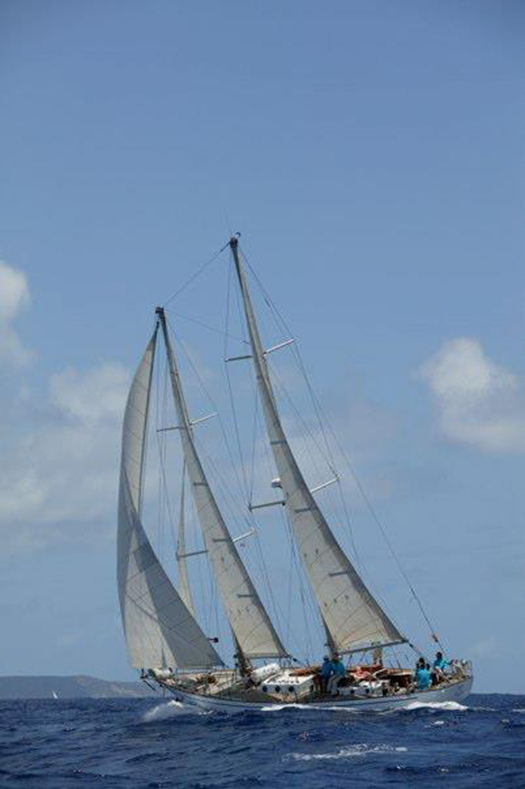
Spirit of Oysterhaven has been doing great work in keeping sail training alive in Ireland
But having the ship is one thing, paying the fees for the trainees to be aboard is something else, and sail training bursaries are one of the key areas of expansion in current maritime development in Ireland. There was an unusual turn to this in 2014 when somebody came up with the bright idea of using Irish Cruising Club funds (which are generated by the surplus from the voluntary production of the club's Sailing Directions) to provide bursaries for youngsters to take part in last summer's ICC 85th Anniversary Cruise-in-Company along the southwestern seaboard on Spirit of Oysterhaven.
The idea worked brilliantly, and this concept of neatly-tailored sail training bursaries is clearly one which can be usefully developed. But still and all, while it's great that young Irish people are being assisted in getting berths aboard charismatic vessels like Europa, the feeling that we should have our own proper sail training ship again is gradually gaining traction, and this is where the Atlantic Youth Trust comes in.
The AYT had its inaugural general meeting in Belfast as recently as the end of September 2014, so it may not yet have come up on your radar. But as it has emerged out of the Pride of Ireland Trust which in turn emerged from the Pride of Galway Trust, you'll have guessed that Enda O'Coineen and John Killeen are much involved, and they've roped in some seriously heavy hitters from both sides of the border, either as Board Members or backers, and sometimes as both.
The cross-border element is central to the concept of building a 40 metre three-masted barquentine, a size which would put her among the glamour girls in Class A, and could carry a decidedly large complement of 40 trainees, even if you're inevitably talking of stratospheric professional crewing costs.
However, by going straight in at top government level on both sides of the border, the AYT team are finding that they're pushing at a door which wants to open, particularly after the new Stormont House agreement was reached in the last days of 2014 to bring a more enthusiastic approach both to cross-community initiatives in the north, and cross border co-operation generally.
Who knows, but if they can succeed in getting cross-community initiatives working in Northern Ireland, then they may even be able to swing some sort of genuine Dublin-Cork shared enthusiasm in the Republic, for I've long thought that one of the factors in holding back many maritime initiatives in Ireland is that, while Dublin may be the political capital, Cork is quietly confident it's the real maritime capital, and does its own thing.
Be that as it may, the AYT have done serious studies, and their conclusion is the best scheme to learn from is the Spirit of Adventure programme in New Zealand. This is where the feeling of going back to the future arises, for in looking at photos of their ship Spirit of New Zealand, there's no escaping the thought that you're looking at Jack Tyrrell's concept ship of 1954 brought superbly to life.
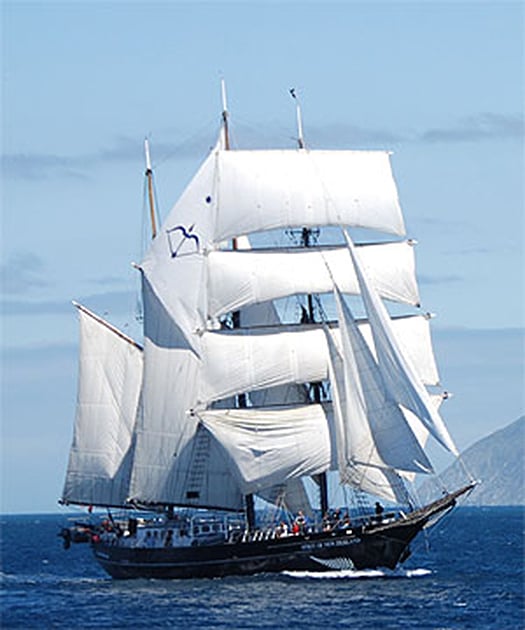
Spirit of New Zealand

Spirit of New Zealand almost seems like a vision of 1954 brought to life...

.....and that vision is Jack Tyrrell's 1954 concept for a 110ft sail training ship
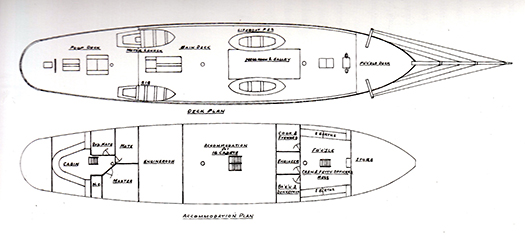
The 1954 accommodation drawings for the 110ft ship hark back to a more rugged age. Imagine the difficulties the ship's cook would face trying to get hot food from his galley on deck amidships all the way back to the officers in their mess down aft
We needn't necessarily agree with all the AYT's basic thinking For instance, they assert that Ireland is like New Zealand is being an isolated smallish island. It depends what you mean by "isolated". Those early sail training pioneers, the Vikings, certainly didn't think of Ireland as isolated. They thought it was central to the entire business of sailing up and down Europe's coastline.
Thus any all-Ireland sail training vessel would be expected to be away abroad at least as much as she'd be at home, whereas Spirit of New Zealand is usually home – the season of 2013-2014 was the first time she'd been to Australia since 1988, when she was in the fleet with Asgard II for the First Feet celebrations.
In New Zealand, she's a sort of floating adventure centre, and a large tender often accompanies her to take the trainees to the nearest landing place for shoreside adventures, for it's quite a challenge keeping 40 energetic young people fully occupied.
In Europe, that's where the sail training races come in. Time was when the racing aspect was down-played. But there's nothing like a good race to bring a mutinous crew together, and the recently-published mega-book about the world's sail training vessels, Tall Ships Today by Nigel Rowe of Sail Training International, quite rightly devotes significant space to everything to do with the racing.
Thus if we do get a new sail training ship for Ireland, she'll have to sail well and fast. That was Asgard II's greatest virtue. For there is nothing more dispiriting for troubled young folk than to find themselves shackled to the woofer of the fleet. Yet you'd be pleasantly surprised by how previously disengaged youngster can become actively and enthusiastically involved when they find that they're being transformed from scared and seasick kids into members of a winning crew.
So now, the 64 thousand dollar question. The cost. It's rather more than 64 thousand. AYT reckon they'll have to come up with a final capital expenditure of €15 million to build the ship and get her into full commission with proper crewing and shoreside administration arrangements in place. But after that – and here's the kernel of the whole concept – they reckon that the running costs will come out of existing government expenditure already in place and used every year for education, youth training, sporting facilities, social development and so forth.
So their pitch is that if the governments north and south come up with funding to support substantial donations already proposed for AYT by various benevolent national and international bodies, then once the ship is in being, she will generate her own income in the same way as vessels like Europa and Morgen Stern are already doing in mainland Europe.
And it's to the heart of mainland Europe that they'll be looking for design and contruction, as it's the Dykstra partnership which will be overseeing the design, and their ship-build associate company Damen will likely do the construction work, though one idea being floated is that Damen might provide a flatpack kit for the vessel to be built in steel in Ireland.
Those of us who dream of Asgard II being built anew will find all this a bit challenging to take on board. My own hopes, for instance, would still be to build Asgard II again to Jack Tyrrell's lines, but with the hull constructed in aluminium. It would be expensive as it would need to be double-skin below the waterline, but the ship's size would be very manageable with a professional crew of just five, while she'd sail like a dream And proper top-class marine grade aluminium seems to last for ever, as naval architect Gerry Dijkstra (his surname is slightly different from that of the partnership) himself shows with his remarkable cruises with his own-designed alloy 54-footer Bestevaer.
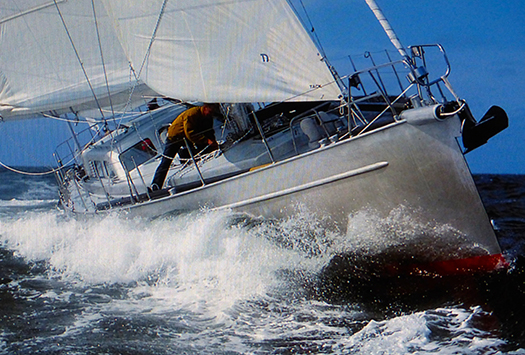
A man who knows what he's doing. This is Gerry Dijkstra's own extensively-cruised alloy-built 54 footer Bestevaer. The name translates not as "Best ever", but either as "best father" or "best seafarer", and was the name of affection given to the great Admiral de Ruyter by his loyal crews
Whatever, the good news is that things are on the move, and we wish them well, all those who have kept the Irish sail training flame alive through some appalling setbacks. Now, it really is the time to move forward. And if we do get a new ship, why not call her the Jack Tyrrell? He, of all people, was the one who kept the faith and the flame alive.
- Tall ship
- Belfast
- Jack Tyrell
- Kristiansand
- Aalesund
- Titanic
- maritime
- Class A
- square riggers
- George Stage
- Alexander Von Humboldt
- Christian Radich
- Sorlandet
- Shtandart
- Brigantine
- Asgard II
- Elaine Byrne
- Erskine Childers
- Sean Flood
- Naval
- Afloat magazine
- boatyard
- sail training ship
- Coiste an Asgard
- Charlie Haughey
- Colm Newport
- Irish Cruising Club
- Spirit of Oysterhaven
- Enda O'Coineen
- John Killeen
- Dykstra
Photo Collection Documents Launch Of The Titanic
#Titanic - The year won't be complete without sharing this wonderful collection of images from the launch of the RMS Titanic at Belfast Lough in 1911, courtesy of the Belfast Telegraph.
The stunning photographs were taken by John W Kempster, a senior engineer at the Harland and Wolff shipyards, as the ill-fated vessel was moved from her slipway into the lough.
And they were never seen in public before their unveiling in October at the Ulster Folk and Transport Museum, where they will remain on display till next summer.
Apart from the Titanic, the photo collection also documents the construction of her sister ship the Olympic, on which Kempster and his family sailed to America on her maiden voyage.
The Belfast Telegraph has much more on the story HERE.
H&W Headquarters and Drawing Offices to be Restored
#TitanicDrawingOffice- Northern Ireland's Alliance East Belfast MLA Judith Cochrane has welcomed the £5m grant from the UK's Heritage Lottery Fund programme that will restore the Harland & Wolff headquarters building and drawing offices in the Titanic Quarter.
Build.ie reports that the Grade B+ listed building will be turned into a boutique hotel which will create 109 jobs.
Judith Cochrane MLA said: "It is great news that a key part of our shipbuilding heritage will be restored with this grant. I hope this new hotel will become another place for tourists to see part of the Titanic's history.
"The new jobs created by this hotel will be a big boost to the local economy."
Belfast Woman Remembers Titanic On 106th Birthday
#Titanic - Mary Millar was four years old in 1912 when she watched the Titanic sail out of Belfast Lough on its fateful voyage - and she's still with us more than a century later, recently celebrating her 106th birthday at Titanic Belfast.
UTV News reports on the special event on Sunday 13 October, where Millar recalled the excitement of seeing the massive ship sail out to sea, and remembered seeing only three of its massive funnels putting out smoke.
She has another connection to the ship, too, as her late husband James worked at Harland and Wolff for many years, following the footsteps of his father - who himself may have been part of the Titanic build team.
UTV News has much more on the story HERE.
Titanic Emotions
#oga50 – There's a nasty old quip which defines mixed feelings as the emotions you experience while watching your mother-in-law drive your new Beemer over a cliff. Quite. But if you want to experience mixed feelings in a more socially acceptable way, try a visit to the Titanic Quarter in Belfast which, in its waterfront areas at least, manages to serve up high-speed mood swings whichever way you turn. Or so it seems to those of us who grew up in a sort of Titanic Disaster Denial environment.
There were many families in the greater Belfast area with an involvement at some level in the city's large and varied engineering industry. My mother's family was one of them. These clans took the loss of the Titanic to heart. It simply wasn't discussed in the family home. And if a stranger did happen to mention the T-word, the matter would be dismissed with a curt remark about there being seventeen other ships under construction in Belfast in 1912, and the loss of the Titanic was only a blip in the onward march of a great industrial port.
These days, things have lightened up a bit with the droll Belfast response that the ship was okay when she left Ulster. But then the pot is stirred again by the likes of Billy Connolly with his question as to what the Catholics of Belfast were doing when the Protestants were building the Titanic. The answer is they were building an iceberg.
For Belfast the feeling was that, as far as the fate of the Titanic was concerned, they wanted to move on. It was the rest of the world which was like an old dog with a bone, worrying away at a bit of receding history. But alas, the dog got younger, and the bone got juicier. And it was one of their own, Northern Ireland-born film producer William MacQuitty, who revived the story with an excellent movie which he called A Night to Remember, a double-edged title in light of Belfast's hidden wish to be allowed to forget.
After that, it was open season, culminating in James Cameron's special-effects-laden Hollywood blockbuster, made when blockbusters still made money. With the Centenary approaching in 2012, and Belfast needing investment in some visionary project to revive the moribund shipyard area where ship-building had ceased a decade earlier, there was nothing for it but to go with the flow, and go for it wholeheartedly. And now, with the extraordinary Titanic Belfast centre dominating the east bank of the River Lagan, they have a visitor attraction which, in terms of numbers crossing the threshold, is rivalled in the Irish context only by the Guinness Storehouse in Dublin.

The new Titanic Centre is at its most impressive at night Photo: W M Nixon
With the Titanic Belfast centre have come other consumer-friendly amenities, such as the new Belfast Harbour Marina. It's still in a fairly raw state, with Portaloos rather than a shower block, while finger pontoons have yet to be installed in the inner section. But that means there are many metres of clear walkway which provide easy berthing for slow-manoeuvring old gaffers of all sizes, so the OGA 50 Round Britain cruise-in-company descended on it last weekend big time.
Last week, we were discussing the reality that bowsprits are marina managers' nightmares, and were soon emailed the helpful info that in the trade, bowsprits are known as dock probes. Moreover, your dyed-in-the-wool old gaffer will think it an affront when marina staff try to charge him or her for berthing fees for the bowsprit. Indeed, a genuine old gaffer will think that, as the boat brings so much character and interest to an otherwise bland modern yacht harbour, not only should the management abandon any notion of being paid for the bowsprit, but as a gesture of goodwill and welcome, they should knock a metre or two off the length of the boat's hull for billing purposes.
Ideally, in fact, they should charge the Old Gaffers nothing at all. That's what Belfast was doing last weekend, so a very varied fleet was in the marina in the final burst of hyper-sunshine. And as the marina is in the Abercorn Basin, for those of us reared in the Belfast nautical tradition, it was just too good to resist, for the Abercorn Basin was the starting point for the epic cruise of the Calabar.
"The Cruise of the Calabar" is a cod-Irish ballad in that classic late Victorian style which is decidedly patronizing. But it's not the worst, so we'll tag it on at the end so that those of you who can't stand such things can make a timely exit. Meanwhile in Belfast we were fairly wallowing in nostalgia, with the OGA50 visit off the launching pad with a reception in the Harbour Commission Offices, which the blurb told us is an impressive 150-year-old ornate Italian-style palazzo.
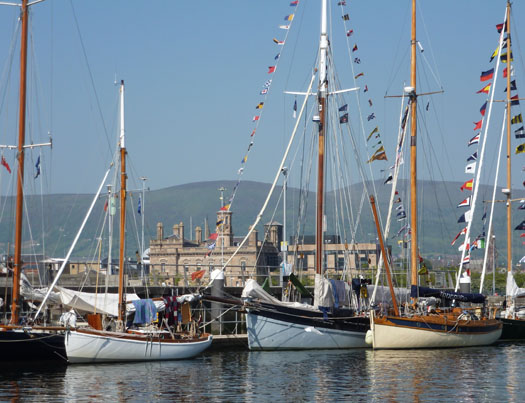
The Belfast Harbour office seen beyond Raven from the Netherlands, the pilot cutter Annabel-J, and the Heard 33 Toucando.
Photo: W M Nixon
Despite having spent some weeks in this palazzo during some work experience between school and college a very long time ago, I hadn't really registered its specially exuberant style, perhaps because Belfast – notwithstanding its being a very Presbyterian city – had acquired a remarkable number of Italianate buildings during its period of mega-growth in the latter half of the 19th Century. The place was up to its tonsils in Italianate buildings, and you could soon have enough of them. Then too, I was allocated to the engineers department, which was in a more workmanlike part of the building.
There, our day was punctuated each morning at precisely 10.30 by the determined squeak of the Harbour Engineer's shiny brown brogues as he strode purposefully down the corridor, resplendent in his immaculate tweed suit and with all the burly presence of a former rugby international, marching out the huge front door and straight across Corporation Square to the nearest bar, where he would down his first large whiskey of the day exactly a minute after opening time.
While the main parts of the Harbour Office may have been palatial, beneath it there was a warren of cellars where many of the rooms had been tastefully adjusted by the senior engineering staff for their own personal comfort. Long before the post-prandial power nap became recognized as an essential part of life for top executives, the senior engineers of Belfast harbour were practising it in their subterranean boudoirs, and it wasn't unknown for some of them to overnight for a few days when the nagging of their wives became intolerable.
As to being an intern in harbour engineering, all I can remember is that it was in the early days of echo sounders, and my work experience consisted in trundling off to some remote corner of the harbour in one of the well-appointed launches with a couple of dry-humoured engineers to spend some time discovering that the new echo sounder was on the blink yet again, and then heading back to base in order to be in the office for close of work.
These days, of course, the pace of work in Belfast Harbour engineers department is much more hectic, and only this week it was announced that they're about to build Ireland's first proper terminal to berth cruise liners. But it was a boat at the other end of the size scale which took pride of place among the Old Gaffers in the Abercorn Basin last Saturday, for there, sailing about as easy as you please, was Lilias, a restored Waverley class sloop.
The Waverleys are the quintessential Belfast Lough class. While the area's many upwardly mobile yachtsmen around 1900 were turning to the likes of Fife and Mylne and Linton Hope to design their burgeoning new One Design boats, down at Whitehead at the seaward end of the northern shore of the lough, the members of the very local if grandly named County Antrim Yacht Club were turning to one of their own, John Wylie, for the design of an 18ft keelboat which would be affordable, robust enough to cope with Whitehead's very exposed anchorage, and small enough to store in the boathouse.
Wylie was the technician in the laboratory of the Physics Department in Belfast's Queens University, and his work there was so highly regarded that, when he retired, they awarded him an honorary degree. As an amateur boat designer, his output was very small, but with the Waverley he hit the target spot on. At first glance, you'd think they're one of the Solent's famous X One Designs with the after end cut down from a sawn-off counter to a transom stern. But in fact the Waverley well pre-dated the X Boats of 1911, so these little Belfast Lough 18-foot keelboats are sui generis.
Little is the operative word – in size they're midway between a Mermaid and a Squib. Yet thanks to a full-bodied yet surprisingly fast hull, they can accommodate a reasonable cockpit with bench seats each side, making them much more comfortable to sail than, say, a Howth 17.
The first three boat were sailing off Whitehead by 1903. Initially the builder was the great Belfast backstreet boatbuilder Paddy McKeown, who couldn't read or write, but was a genius at interpreting boat plans. The class was soon popular, and they'd dozens of attractive boat names to draw on, as all were named after characters in Scott's Waverley novels. By 1906 Lilias was among those from McKeown joining the fleet. Once the boats went to Whitehead, they seldom if ever returned to the yard, so when Jeff and Janet Gouk brought their lovingly restored little boat into the Abercorn Basin from Bangor eight days ago, it was quite possibly the first time she'd been back in Belfast in 107 years.
The class is now only extant - and in a very limited way at that - in Bangor. Unfortunately, while the harbour there has a first class marina, there are no swinging moorings, which are important for supporting little old local one design classes. But despite the problems of getting in and out of their berth, people still love to sail Waverleys, and last year Lilias rounded out the season by being winner of the Lufra Cup, Ballyholme's time-honoured come-all-ye pursuit race.
In their heyday the class had strong fleets at both Whitehead, and Ballyholme across the lough, with very healthy inter-club rivalry. Inevitably the increasing popularity of bermudan rig brought friction. John Wylie would have nothing to do with it, so in 1935 some owners commissioned the designs for a Bermudan rig from Alfred Mylne in Glasgow. World War II interrupted the movement for a changeover, but when my uncle bought the Waverley Montrose (no 13) in 1945, he changed her to bermuda rig the following Spring.

The Waverley Class Montrose as she was in 1945 at Ballyholme, still carrying original gunter rig
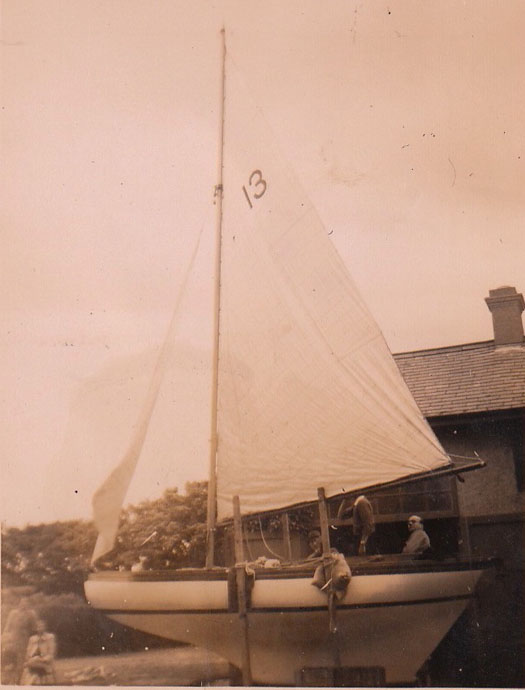
Montrose with a dry land trial for her controversial new Bermuda rig in the Spring of 1946.
My father sailed with him, and the two of them were like a pair of schoolboys, so impatient to see the new rig they put it up in the yard at home. Soon my father had his own Waverley, Rowena (no 1), and as she was already Bermuda rig, between the two boats there was quite a bit of success, especially in light breezes. Yet still other boats stuck with the original gunter rig, claiming that the only true Waverley was a gunter-rigged one, and disdaining the success of the Bermuda boats. So at the class AGM in April 1948, my uncle proposed and my father seconded a motion that all Bermuda boats revert to gunter rig. It sounds very sporting. But it was mischief-making typical of the two brothers-in-law - in a month's time, they were taking delivery of their new co-owned 25ft Glen One Design and exiting the Waverleys, leaving their former classmates with this contentious proposal simmering on the back burner for years.
It arose again in 1950 when the Bermuda-rigged Waverley Fair Maid foundered in a sudden gale while crossing Belfast Lough from Ballyholme back to Whitehead, with the loss of four lives. The class at Whitehead never really recovered from this tragic setback, and many lost faith in the gallant little boats. But then in 1961 brothers Kevin and Colm McLaverty, with Mick Clark as third hand, cruised round Ireland in handsome style from Carrickfergus with the Bermuda-rigged Waverley Durward, and the design resumed its rightful place of respect as a remarkably able little boat.
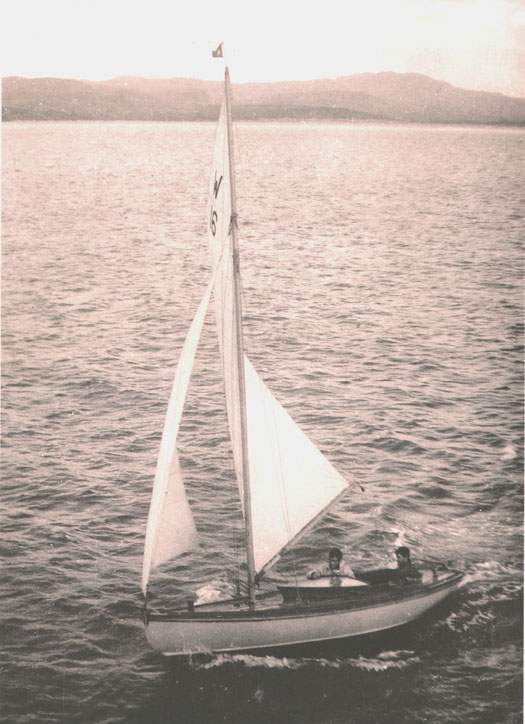
Durward at Sheephaven in Donegal during her round Ireland cruise in 1961. Photo: Kevin McLaverty
However, the class weren't finished with misfortune. By 1976, it was undergoing a new lease of life, with 13 boats all at Ballyholme, and all carrying gunter rig. But while Ballyholme Bay is a good passage anchorage in offshore winds, and a great place to sail, it's much too exposed for moorings. Yet in those days there was nowhere else in Bangor to keep a boat, and in September 1976 the Waverleys paid the price in a storm force northerly. The lucky boats were those that sank – they survived with only partial damage on the seabed. But those that were driven ashore became matchwood. And of the only two still floating, one sank the final inch while they were putting pumps aboard in the post-storm calm.
Yet the spirit of the Waverleys lived on, and by their Centenary in 2002-3, they were sailing as a class again. So the chance to sail aboard Lilias with Jeff Gouk – the first time for me in a Waverley since crossing the North Channel in Durward in 1961 - was top priority in Belfast, and every moment was pure joy. They're absolute honeys to sail, with good ergonomics, lovely handling, and everything as light as a feather.
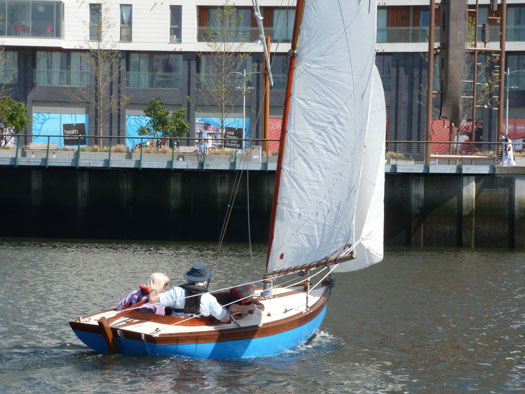
Lilias is all of a piece, a beautifully restored little sloop. Photo: W M Nixon
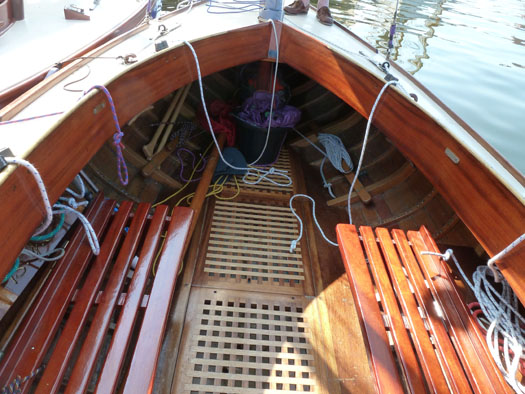
The cockpit on Lilias is much more comfortable than on many craft of similar size. Photo: W M Nixon
And there was new interest in the OGA 50 fleet, as Adrian "Stu" Spence's 1875-built Pilot Cutter Madcap had joined up, as had Isabel Hood's 1894-built Glance. There's one thing which all the old gaffer boats have in common. They're likable boats, every last one of them, and clearly their owners love them dearly. Thus with Madcap, the accommodation is so sensible and friendly, it could usefully be transposed to many modern boats. And as for Glance, that gallant old veteran which was already 61 years old when she won the Jolie Brise Cup for the Hopkirk brothers of Belfast in the 1953 Fastnet, she simply exudes good vibes on deck and below.
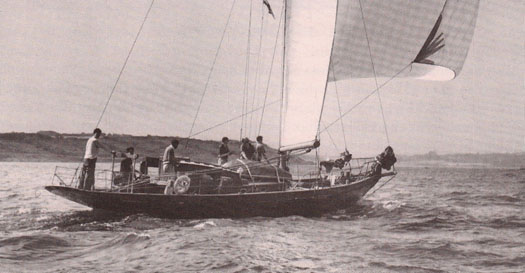
The 1894-built Glance on her way to winning the Jolie Brise Cup in the 1953 Fastnet.

Glance's attractive accommodation works well both at sea and in port. Photo: W M Nixon

The pilot cutter Annabel-J made for an ideal party boat Photo: W M Nixon
The Belfast visit was very much a voyage across the seaways of memory, and we made a point of heading for Tedford's seafood resturant on Donegal Quay for dinner after a fine old party aboard the big pilot cutter Annabel-J. In days of yore, Tedford's was the chandlers and sailmakers which were the first port of call in Belfast for any impecunious young skipper when fitting out. They carried an enormous stock, they would try to do things to old sails that no other sailmaker would contemplate, and they were very kind in extending credit until Christmas when there was a faint hope some kind aunt might see her way to a sensible cash gift.
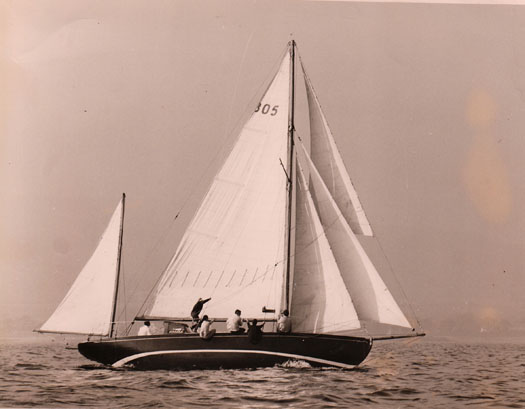
Ainmara with her "new" mainsail in 1967, re-cut from Griffin II's former sail with maximum economy by Billy the Twitch of Tedford's. Photo: Denis Pogson
It was a place of character and characters, whether it was Jimmy with his eternal duncher cap, I suppose you'd call him the sales executive, or Billy the Twitch, who was the sailmaker. Billy finally gave in to Dickie Gomes' persuasive powers and reduced the large second-hand mainsail somehow acquired from the RORC Club Yacht Griffin II into Ainmara's first terylene mainsail in 1967. It was such an economy job that he simply left half the sail number on the new leech. Though very heavy, it was an excellent sail, living testimony to Tedford's skill and tolerance

Tedford's classic and unchanged exterior today, with (left to right) Ed Wheeler, Dickie Gomes and Brian Law. But within, there isn't a trace of the old place as they knew it in the 1960s. Photo: W M Nixon
Anway, we dandered along to Tedford's in the velvet warmth of the summer evening, and it was reassuringly exactly the same outside. But inside, though the seafood is really good, there's not one single artefact or picture to remind you that this used to be a chandlery and sailmaker so perfect it was like a stage set. Instead, you've just another 21st Century restaurant.
So the meal was fine, but we felt a little cheated. But the next item on the agenda was the real McCoy, the first function to be held aboard the newly-restored Nomadic, which was the tender ship which took the passengers from Cherbourg out to the Titanic in April 1912. Superbly organized by Alan and Irene Aston of the Belfast OGA, this party was mixed feelings with turbo-power. You don't need much imagination to visualise the passengers of 1912 crowding the little ferry ship. You don't need any imagination – the Nomadic is crammed with ghosts.

The haunted ship. The Nomadic is crammed with ghosts. Photo: W M Nixon
And outside, glowing in the night, was the astonishing Titanic building. We'd a special link to this, as its remarkable exterior surface was designed was created by Alan Grimason. Back in the day, "Grim" (he's anything but) was an early crewman on Ainmara, and he was the man to call on for name-painting on boats at the right price. We still have the boats being run if at all possible at the right price, but with his Titanic building Alan has moved on – it's remarkable in daylight, at night it's astonishing.
On Sunday morning, boats were already moving on towards Scotland. But for the many who stayed, there was a river-cruise up the Lagan for a very good barbecue at the new pub at Cutter's Wharf. They were to have yet another party on a barge in the city that night, but several of us took our farewell from the OGA50 rolling circumnavigation at Cutter's Wharf. And where better? For we had just re-lived the Cruise of the Calabar:
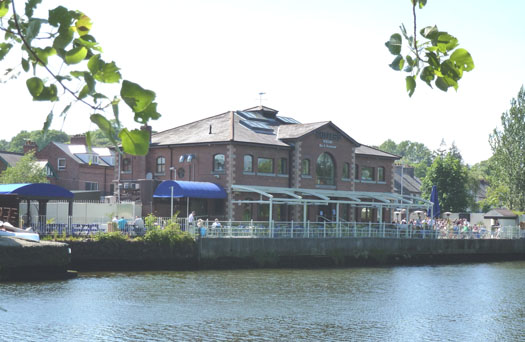
Destination for a 21st Century Cruise of the Calabar – Cutter's Wharf on the River Lagan at Stranmillis in south Belfast.
Photo: W M Nixon
The Cruise of the Calabar
Come all ye dry-land sail-y-ors and listen to my song,
"Tis only forty verses, so I won't detain yous long,
It's all about the voyagings of this old Lisburn tar
Who sailed as man afore the mast aboard the Calabar.
Now the Calabar was a spanking craft, copper-fastened fore and aft,
Her helm it stuck out far behind, and her wheel a great big shaft,
With half a gale to swell each sail, she'd make one lock per hour,
She's the fastest craft on the Lagan canal, and only one horse-power.
The Captain was a strappin' lad, he stood full four foot two,
His eyes was black, his nose was red, his cheeks a Prussian blue,
He wore a leather med-i-al that he won at the Crimea war,
And his wife was steward and passengers' cook aboard the Calabar.
"Come here me lad" the captain says, "come here" says he to me,
"Would you like to be a sail-y-or and roam the raging sea?
Would you like to be a sail-y-or the foreign seas to roll
For we're under orders for Portadown, with half a ton of coal."
We left the Abercorn Bas-i-on, the weather it being sublime,
And passing through the old Queen's bridge we heard the "Albert" chime.
'Tis then we came to the Gasworks Straight, a very dangerous part,
And ran head on to a lump of coal that wasn't marked on the chart.
Then all became confus-i-on, the stormy winds did blow,
The mate slipped up on an orange peel and fell into the hold below,
The captain called for much more steam, for we were sorely pressed,
But the engineer from the shore replied, "The oul horse is doing his best."
Next morning when we wak-i-oned, we was in a terrible funk,
The mate he had been drownded dead while sleeping in his bunk,
To save the ship from sink-i-ing, and to save each precious life,
We threw the cargo overboard, along with the captain's wife.
A farmer going to his work did hear our piteous roar,
He threw us the end of his galluses, and pulled us to the shore.
I'm done with ocean rambl-y-in', and roamin' the ragin' main,
And the next time I go to Portadown, I'll go there by the train.
Restoration of Titanic’s Tender SS Nomadic Completed
#TitanicTender – S.S. Nomadic as previously reported on Afloat.ie, is a veteran of two world wars and has a direct link to the luxurious RMS Titanic past, and Charlie Chaplin and Elizabeth Taylor who have been on board the passenger liner tender.
As of today, the last remaining vessel of the White Star Line, will be open for visitors in her dry-dock next to the Titanic Belfast Visitor Centre and close to where she was launched in 1911 at Harland & Wolff.
She was built to ferry first and second class passengers to RMS Titanic from Cherbourg in France, a port too small for what was at that time the largest ship in the world. For more on this the BBC reports.
Afloat.ie adds that another former trans-Atlantic liner tender that served in Cork Harbour, (Titanic's last port of call), the T.S.M.V. Cill Airne ran from Cobh out to the liners during a short career until the early 1970's.
The Dublin-built vessel launched in the early 1960's is now a static restaurant and bar venue and is also open to visitors today and throughout the Dublin Port River Festival (1-3 June).
Titanic Belfast Is 'Euro Tourism Success Story'
#Titanic - Titanic Belfast is second only to the Guinness Storehouse in terms of visitor numbers in its first year, as The Irish Times reports.
NI Deputy First Minister Martin McGuinness, who joined First Minister Peter Robinson at an event to mark the first anniversary of the Belfast Lough-side visitor centre's opening, said the total of 807,340 visitors exceeded expectations and is “an outstanding European tourism success story”.
Operators of the Titanic Visitor Experience at Titanic Belfast said people from 128 different countries had come to see the exhibits, including Britain's Queen Elizabeth II and noted Titanic enthusiast James Cameron.
The Irish Times has more on the story HERE.
Amazon Chief Finds Apollo Rockets On Atlantic Ocean Floor
#Saturn5 - Hollywood hitmaker James Cameron might have the exploration of the Titanic all sewn up, but Amazon founder Jeff Bezos has just made a deep-ocean discovery of his own.
Reuters reports that a team funded by the online retail boss has pulled up from the depths two engines from the Saturn 5 rocket that sent Nasa's Apollo missions to the moon.
Bezos announced the historic find on Wednesday, explaining how the team found and recovered the two first-stage engines from the ocean floor some three miles below the surface of the Atlantic.
He wrote on the Bezos Expeditions site: "We've seen an underwater wonderland - an incredible sculpture garden of twisted F-1 engines that tells the story of a fiery and violent end, one that serves testament to the Apollo program."
It's not certain what mission the engines were used for as the serial numbers are incomplete, but it's hopeful that their origin can be narrowed down during restoration ahead of their eventual public display.



























